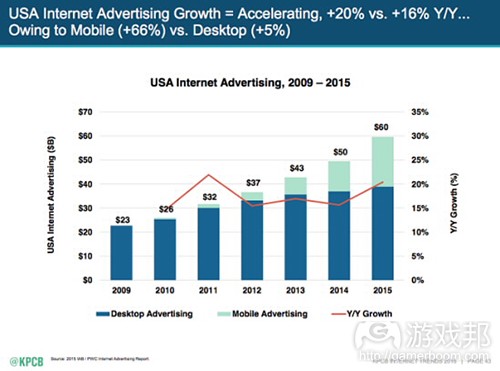市场营销者该如何在手机游戏中设置广告
作者:Mark Rosner
从最初无数简单,低分辨率且无目标的横幅广告开始出现在手机屏幕上以来,手机广告产业已经走了很长的一段路。
而正是那些简单,纯天然,看似无效但却创造了大量点击的广告为众多复杂的手机广告形式创造了条件。所以现在那些早前的在线媒体购买已经被更复杂的数据驱动购买所取代,即致力于通过收集广告去榨取每一滴利润率。
品牌所拥有手机广告机遇是非常显著的,单单去年再现广告收益便达到了600亿美元,即相比2014年提升了整整20%。相比增长了66%的手机广告收益,桌面广告收益却只增加了5%。尽管这里存在巨大机遇,但是研究表明比起用户花费在智能手机和平板电脑上的时间,品牌的消费似乎远远不够。
为了帮助开发者更好地了解这个受手机广告驱动的全新世界,我们将在此分享如今最热门的手机广告形式。
手机视频广告
视频广告是提高品牌认知最理想的方法,即能够支持潜在的顾客开发流程以及不断提高的用户粘性。这种广告形式似乎从未有后退的趋势:根据预测,单单在美国数字视频广告到2020年的消费将达到280.8亿美元,即比起现在的99亿美元拥有巨大的增长。
数字视频广告能让广告者在手机平台上建立起强大的联系,即在许多数字频道以及像智能手机和平板电脑等不同设备上呈现具有较高针对性的内容。视频广告同样还能够提供更出色的终身价值。即它们会先衡量用户质量并传达基于视觉效果的体验。同时视频广告也是各种不同类型的品牌的最佳传播渠道,即能够永远宣传即将问世的电影,视频,音乐,零售商品,当然也有游戏。
所以为了获得成功,品牌需要明确了解自己的目标用户并传达符合用户兴趣的视频内容。为了提高用户留存和利润率,所有视频广告内容不仅需要传达明确的价值,同时也应该尽早呈现在用户面前。
可游戏手机广告
这种全新广告形式是让玩家可以真正游戏的内容。作为一种全新且有效的广告形式,可游戏广告能让消费者在真正安装应用前先尝试下游戏内容。通过这种类型的广告游戏也能真正吸引像休闲玩家等用户的注意。这些广告将模糊应用与广告间的界限,并提供给玩家更加丰富的体验,即让他们愿意将宝贵的时间投入在与广告的互动中。
这种广告不仅有趣,同时也能够带给市场营销者一些益处。首先,可游戏广告能够创造更有效的转换率,因为它们是具有互动性的,且拥有比一般广告更快的转换速度。
同时可游戏的广告也能够提供更强大的终身价值。它们会事先衡量消费者的质量从而提供一些更有深度的体验:所以比起像故事,视频等广告渠道,这类型广告能够更有效提高用户粘性。
图像插播手机广告
这种全屏广告形式会在屏幕上待到用户能够点击角落上的“x”标志去关闭广告。这能够有效提高品牌认知度并有效利用整个手机屏幕而不只是屏幕上的一小块地。如果能够有效设置,插播广告对于玩家的干扰便能够得到最大限度的压缩。
在这个注意力广度逐渐缩短的时代,插播广告能够有效抓住用户的注意并因此提高游戏的用户粘性,点击率和转换率。同时这类型广告也不需要像视频广告或可游戏广告那样占用太多时间,并且对于一些应用来说,更快速的广告体验可能也更好。
不过这里也存在一些弊端:插播广告总是会强迫用户必须盯着它们看纸直至能够点击关闭,如果这类型广告的出现时机不对便会因此惹恼许多玩家。所以广告者在设置插播广告时一定要万分谨慎,即最好是将其设置在游戏关卡之间,即自然出现在应用中,或者将其呈现在一个游戏回合的最后或者一个特定的应用功能中。
原生手机广告
原生广告是一种付费内容,即能够匹配应用的“原生”形式,所以这种广告往往不会过多地打扰到用户。原生广告拥有和应用相同的设计元素,副本布局,UI和按键。手机市场营销者在设计原生手机广告时需要保持6大元素不变:缩略图,标题,描述,品牌logo和品牌名。
通过传递与发行商所使用的相同形式的广告,这些广告总是能比传统手机广告获取更多点击率。
原生广告总是很受品牌的欢迎,因为比起传统广告它们能够创造更高的点击率,并且也能创造强大的用户粘性。但是这里也存在一些弊端,即有些用户会觉得原生广告具有误解性,并且这有可能破坏发行商和品牌的声誉。为了避免这种情况,发行商就必须确保原生广告能够遵从MMA指导方针。
结论
并不存在“最佳”手机广告形式。该选择怎样的广告是取决于各种各样的元素,如游戏或应用类型,环境,广告的设置位置以及出现频率等等。
随着手机设备的不断增加,特别是智能手机成为了消费者最佳设备选择,市场营销者就需要选择最合适的广告形式去推动游戏的收益增长。
(本文为游戏邦/gamerboom.com编译,拒绝任何不保留版权的转发,如需转载请联系:游戏邦)
The marketer’s guide to mobile ad formats
By Mark Rosner
The mobile ad industry has come a long way since millions of primitive, low-res, untargeted banner ads first started being served across mobile screens.
Those simple, crude, ineffective ads which produced mostly accidental clicks paved the way for a multitude of sophisticated mobile ad formats which present themselves to developers today. Old-form online media buying has been superseded by more sophisticated data-driven buying, designed to milk every last drop of ROI out of mobile ads.
The mobile advertising opportunity for brands is phenomenal – last year alone online ad revenues generated a staggering $60 billion, a whole 20 percent increase on 2014. Mobile ad revenue grew by more than 66 percent whilst desktop advertising increased by only five percent. Despite this booming opportunity, research clearly shows that brands are critically under-spending on mobile, relative to how much time users are spending on mobile devices like smartphones and tablets
To help devs make sense of our brave new mobile ad-driven world, we’ve pulled together what we know are the hottest mobile ad formats today.
Mobile Video Ads
Video ads are an ideal platform for increasing brand awareness, supporting lead generation and increasing engagement. This format shows no sign of abating: In the US alone digital video ad spending is forecast to reach $28.08 billion in 2020, up from an already impressive $9.90 billion in 2016.
Digital video ads empower advertisers to build stronger connections along the route to purchasing on mobile, with highly targeted content across many digital channels and different devices like smartphones and tablets. Video ads also offer better lifetime values. They too qualify users before they reach the advertiser and deliver rich, visual experiences. Video ads are good vehicles for many types of brands and advertise upcoming movies, food, music, retail products and of course, games.
To succeed, brands need to have a clear understanding of their audience profiles and align video content with user interests. To increase retention and ROI all video ad content should be actionable with clear value and calls to action displayed early on in the ads.
Playable Mobile Ads
This inventive format is an advert that is a game that people can actually play. Increasingly considered as a new and effective route to mobile app discovery via gaming demos, playable ads provide a great way for consumers to sample content before installing an app. You can really engage audiences like casual gamers (or anyone else for that matter) with playable content. These ads blur the boundary between apps and ads, offering rich experiences where consumers can spend more valuable minutes interacting with ads.
Whilst being fun in the moment, playable ads also deliver key benefits for marketers. Firstly, playable ads typically deliver better conversion rates – because they’re interactive, they convert much faster than normal ads.
Playable ads also offer better lifetime values. They cleverly qualify consumers before they reach the advertiser as they offer deeper experiences: These users engage at an increased rate than those received from other ad channels like native, video and display.
Graphical Interstitial Mobile Ads
These are full screen ads which stay on a screen for a few seconds until users are given the option to close the ad usually by clicking on an ‘x’ in the corner. Great for increasing brand awareness and making use of the whole mobile screen real-estate instead of just a small portion of screen. With the proper placement, the interruptive nature of interstitials can be held to a minimum.
In an age of diminishing attention spans interstitials are a potent way to grab the complete attention of users thereby increasing engagement, click-through and conversions. They also don’t take as much time and engagement as video or playable ads and for certain areas in an app, a faster ad experience can be better.
There are downsides though: As interstitials often force users to stare at them, only until they’re allowed to click out, lots of users find this quite irritating if shown at an inopportune time. Great care should be taken to display interstitials only in the proper context like between levels on a game, at natural breaks in the app, or at the end of a session or specific app function.
Native Mobile Ads
Native advertising is paid content which matches the app’s “native” format, hence delivering a less interruptive experience for users. Native ads have the same design elements, copy layout, UI and buttons as the app. Mobile marketers need the following six ingredients to deliver native mobile ads: URL, thumbnail, headline, description, brand logo and brand name.
By delivering ads that appear to be in the same format as the publisher or outlet, they’ve proven to be effective at generating higher click rates than traditional mobile ads.
Native ads are extremely popular with brands, chiefly because click-through rates are often much higher when compared to traditional ads, plus engagement is much greater. However, there is a danger that some consumers could feel native mobile ads are misleading, damaging both the reputation of the outlet and the brand. To avoid this, publishers should always conform with MMA guidelines for native ads.
Conclusion
There isn’t just one ‘best’ mobile ad format for all. The choice of format deployed depends on a number of variable factors such as the game or app in question, the context, where the ad is placed and the frequency of placements.
With the proliferation of mobile devices and particularly smartphones as the preferred device for consumers it is essential that organisations deploy the right ad format strategy to leverage mobile platforms to help further drive revenues.(source:develop-online)
上一篇:开始创造手机VR体验的5大建议








































 闽公网安备35020302001549号
闽公网安备35020302001549号